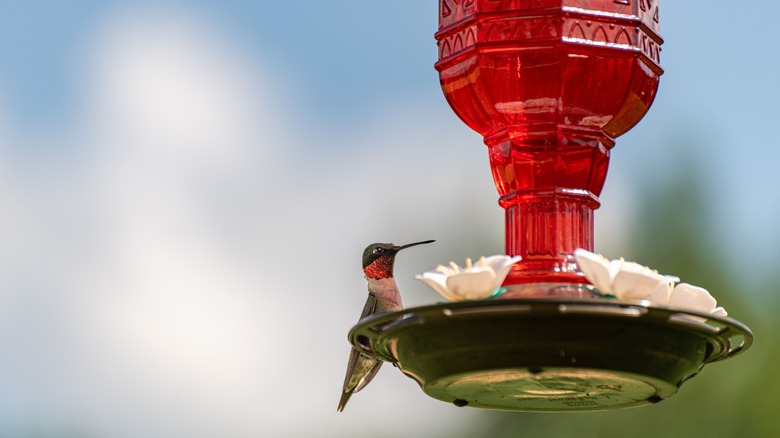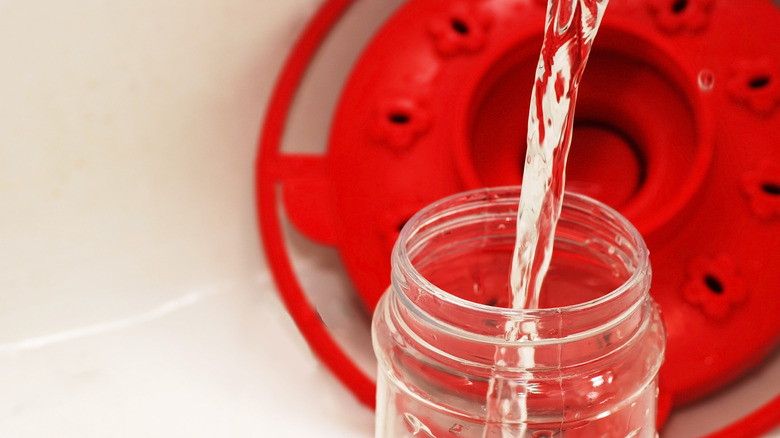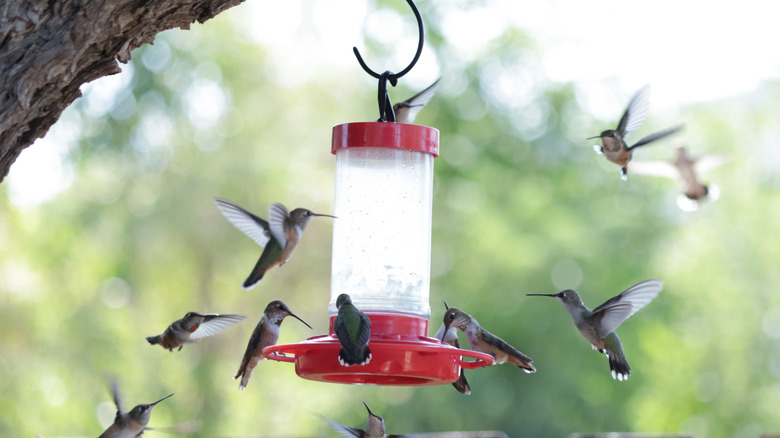When It Comes To Hummingbird Feeders, Is Bigger Better?
When you're a hummingbird enthusiast, it is thrilling to see those tiny birds zipping around your yard or garden. If you've ever considered placing a hummingbird feeder in your backyard, you should absolutely do so if you are able. Not only can this attract hummingbirds to your yard, but you will also help provide them with food to round out their diets. Selecting the perfect hummingbird feeder is admittedly not an easy task, though. While it can be tempting to buy a larger feeder to hold more nectar at once, this may not be the best choice. Too large of a feeder may not be necessary for smaller hummingbird populations, and it can quickly grow mold and lead to wasted nectar when left unused.
A feeder is considered among the essential features for attracting hummingbirds to your garden. While you may be focused on finding the right spot for the feeder in your outdoor space, it's equally important to choose one that is the appropriate size. Hummingbirds eat approximately half their body weight in food every day, but their diets go beyond nectar from feeders. They also feed from nectar-producing flowers and get protein from a variety of bugs. A big feeder can be suitable for a larger flock of hummingbirds. On the other hand, if you have a smaller hummingbird population, this might not be necessary. Consider starting with a smaller feeder, and then you can add more than one during peak migration season in your region, if needed.
Too large of a hummingbird feeder can lead to spoilage and harmful growths
Placing too large of a hummingbird feeder can subsequently mean too much available nectar than is necessary for the number of hummingbirds that frequent your yard. Some people might choose a large feeder in the hopes of not having to change the nectar as often, but the truth is you need to swap out the nectar every couple of days regardless of how much is left. In fact, you may need to change hummingbird nectar daily in the summer, or every 1 to 2 days whenever temperatures exceed 70 degrees Fahrenheit. In cooler weather, you will still need to change out the nectar once every 3 to 5 days at minimum.
Not only can the nectar start to spoil after a while, but old, unused nectar can also increase the risk of mold growth in the feeder. Mold growth can accelerate during warmer weather, and also if insects get an opportunity to leave microbes around the feeder. Also, having a large feeder with too much nectar on hand could inevitably mean the feeders do not get cleaned as often. This might induce mold and bacterial growth, and possibly increase the risk of spreading diseases to hummingbirds that feed from the affected feeder. As a rule of thumb, hummingbird feeders ought to be cleaned each time you change out the nectar.
The bottom line when choosing the right size for a hummingbird feeder
When shopping for hummingbird feeders, you might come across ones that exceed 32 ounces! As a rule of thumb, this is too large for the average garden or backyard, unless you are lucky enough to have dozens of hummingbirds visit every day. Twelve ounces is a good place to start if you have up to 10 hummingbirds feeding per day. Another important factor is the number of ports on the feeder. To avoid excessive fighting, consider choosing one with three to six feeding ports. Additionally, make sure the feeder (and not the nectar) has red colorings to help attract hummingbirds to the site.
Overall, you know you have the right size hummingbird feeder if it is visited frequently, and the nectar lasts for a couple of days. Also, while it's tempting to save time by buying store-bought nectar, know that homemade hummingbird nectar is surprisingly easy to make. Once you make a batch, you can also store extras in the fridge for when it is time to refill your hummingbird feeder. This reduces the need for thinking you need to buy a large feeder, only for the batch of nectar to go to waste. Just be sure you allow the refrigerated nectar to warm up to room temperature again before placing it in your feeders.


